Tomato "Apples in the snow": description and growing rules
Early varieties tomato interested in all gardeners. They are especially relevant for residents of the northern regions, where many late varieties simply do not have time to ripen. One of the earliest varieties of tomato "Apples in the Snow".
Content:
- Tomato "Apples in the Snow": variety description
- Growing seedlings
- Planting tomato seedlings in the soil
- Tomato care "Apples in the snow"
Tomato "Apples in the Snow": variety description
Plants of tomatoes of the "Apples in the Snow" variety are determinant. They are short, about 60 cm, do not need to be tied to a support and pinching... Fruits are round, slightly flattened, not very large, the weight of one varies from 50 to 70 g. The color is bright red, the stalk has no spots. It is appreciated for its high yield and pleasant taste of the fruit. They are fragrant, rather sweet, with sourness. The longer the tomatoes hang on the bush, the sweeter they become. Up to 12 fruits grow on one bush. The yield is stable, regardless of weather conditions.
The variety "Apples in the Snow" is very early.
The first fruits ripen at the end of June, and by the end of July, almost all tomatoes are ready for consumption. The variety was created for cultivation in northern regions, where the number of warm days is small. During this time, he manages to grow, form fruits that ripen before the onset of autumn frosts.
Plants are not affected by apical rot. The only drawback of the variety "Apples in the Snow" can be considered low resistance to the dangerous disease of tomatoes - late blight... This is usually not the case with early varieties. The fruits of this variety are used fresh. You can preserve and prepare salads from them. Some housewives freeze tomatoes for the winter.
Growing seedlings
Tomatoes need a lot of heat and light for successful development. They are grown mainly from seedlings. You can plant in a greenhouse, thin out crops, but such plants will have a weak root system, which will affect the yield. Do not sow seedlings too early. You need to plant it at the age of 30 days. Therefore, you need to count 40 days from the estimated date.
Seed preparation for sowing contains several stages:
- Calibration (remove small and damaged ones).
- Disinfection (processed with potassium permanganate).
- Stimulation (treatment with biostimulants, for example, honey or onion peel infusion).
- Bubbling (air saturation with an aquarium compressor) ..
Prepare the soil:
- It should be light so that the sprouts come out easily. It can be made up of 7 parts of peat, part of sod land with the addition of sawdust. You can mix peat (3 parts) with humus (1 part) and add half a portion of sawdust and humus.
- You can fill the prepared soil mineral fertilizers... One and a half kilograms of ammonium nitrate, 4 kg of superphosphate, one gram of zinc sulfate, potassium permanganate, copper sulfate and 3 g of borax are added per cubic meter of the mixture. These fertilizers can be applied later.
The prepared seeds are sown into the ground to a depth of 2 cm. Water, cover the boxes with foil and set in a warm place. The temperature must be at least 20 ° C. After a few days, shoots appear. In order for the seed coats to be easily removed from the seedlings, you can water the soil with warm water several times.The boxes are opened and placed in a sunny place. The room temperature is lowered to 18 ° C so that the tomatoes do not stretch.
Do not allow waterlogging so that the plants do not die from the "black leg".
One of the mistakes is crop thickening. Do not sow seeds for future use. If the sprouts grow too densely, it is better to immediately remove the excess ones, otherwise they will stretch out and become unusable.
After 2-3 true leaves are formed in the plants, they are abundantly watered and dived into new dishes. This is usually 20 days. Planting depth is about 5 cm. You can use deep boxes or plastic 200-gram glasses. During the dive, the root tip breaks off, and lateral roots begin to actively develop. This helps to strengthen the root system.
The temperature is raised to 25 ° C for a week. If the weather is cloudy or the amount of light is insufficient for another reason, you need to supplement the seedlings with a special fluorescent lamp (phytolamp) so that the daylight hours are at least 14 hours. Potassium addition is an alternative.
The room temperature in sunny weather is set 3-5 degrees higher than in cloudy weather. At night, the temperature should be between 8 and 10 ° C.
If the seedlings will be planted in open ground, then first they need to be hardened. To do this, in 2 weeks, the boxes are taken out into the street, accustoming them to wind, sunlight and temperature fluctuations. First, for several hours, increasing the time every day, and then completely left on the street. Of course, if there is no threat of frost at this time. During the hardening period, the number of waterings is reduced. Before planting, you need to process seedlings from late blight. Feed seedlings mineral fertilizers (potassium sulfate, ammonium nitrate and superphosphate) or organic.
Planting tomato seedlings in the soil
In May, seedlings are planted in greenhouses, unheated greenhouses. The depth of immersion in the ground is 10 cm. When the threat of spring return frosts has passed, the shelter can be removed. The distance between plants is of great importance for the prevention of late blight disease. Early maturing varieties are advised to be planted according to the 30x40 scheme. But due to the tendency of the variety to late blight, it is best to plant them according to the 70x70 scheme. If there is little space, the distance in the row can be reduced to 50 cm. In open ground in the northern regions, for which the variety is intended, it is planted in mid-June. They focus on the possibility of frost, which tomatoes cannot tolerate.
In the northern regions, it is better to plant tomatoes on the southern slopes, protected from cold northern winds. The soil must meet certain requirements. Do not plant tomatoes after nightshades, including eggplant, pepper... Better to use the area where they grew last year cabbage, pumpkin, carrot.
The acidity of the soil should be neutral or weak acidity (pH 6.0-6.7).
If the soil on the site is acidic, it must be limy, adding lime or dolomite flour. A week before planting the plants, the site is spilled with Baikal EM1 fertilizer. It promotes the formation of microorganisms that are beneficial to tomatoes.
During planting, the plants are immersed in the soil to the lower (fake) leaves. If the plants are very tall, overgrown or elongated, they are laid on their side, with the top to the south. Urgas fertilizer is applied to the bottom of the hole (half a teaspoon). Water, wait until the water is absorbed and sprinkle with earth a third or fourth of the length of the trunk.
Tomato care "Apples in the snow"
The main task when caring for apples in the snow is to provide the right amount of moisture before flowering, during the formation of the ovary and before ripening. In this case, it is necessary to create conditions for the free movement of air between the bushes. It will carry away excess moisture, preventing the development of late blight.
Whether tomatoes need pinching and tying to supports - each owner decides for himself. Determinant varieties, which include "Apples in the Snow", can be grown without these procedures.But if there is a threat of late blight, it is better to regulate the number of stems and leaves. And so that the fruits do not fall on the ground, use low supports.
Care Tips:
- The soil on the site must be kept clean of weeds. After all, they take a large amount of nutrients from plants and contribute to the development of phytophthora. Loosening the soil helps to close the moisture after watering.
- Regular feeding increases the yield of tomatoes. You can use a diluted infusion mullein or chicken manure. For this, a liter of dry fertilizer is diluted in 10 liters of water. Insist in a warm place for a week. Then add a liter of infusion to a bucket of water and pour a liter of liquid under each bush. Before and after fertilization, the plants need to be watered. It's good if it makes it rain.
- Tomatoes respond well to fertilizing with mineral fertilizers. They are carried out 3 weeks after planting and during the period of mass fruit formation (after another 3 weeks). In a bucket of water, 25 g of ammonium nitrate, 40 g of superphosphate, 15 g of potassium fertilizers are diluted. This amount for small plants is enough for 15 bushes, and for adults - for 7. Phosphorus fertilizers improve the process of flowering and fruit formation. In the second half of summer, you need to be careful with nitrogen fertilizers. With a cold snap, they can contribute to the fall of the ovaries.
- If the leaves of tomatoes curl and the edge dries up, this indicates a lack of potassium. The fruits become light near the stalk, voids are formed inside. If the plant lacks nitrogen, the leaves become small and light. The plant reacts to a lack of phosphorus with purple leaves. They rise up, pressing against the trunk. Top dressing with organic and mineral fertilizers alternate.
- You should not get carried away with excessive watering of tomatoes. This can lead to the development of fungal diseases. Plants should receive the main amount of moisture during the period of mass ovary formation. They are treated with "Fitosporin" preparations or others intended for the prevention and control of fungal diseases.
The fruits are harvested as they ripen. You can pick brown tomatoes and put them in boxes. This will speed up the ripening period of all fruits from the bush.
More information can be found in the video:



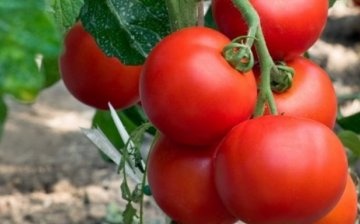
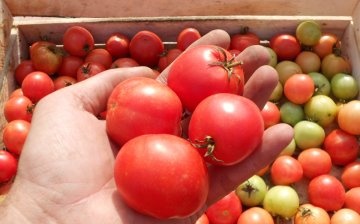
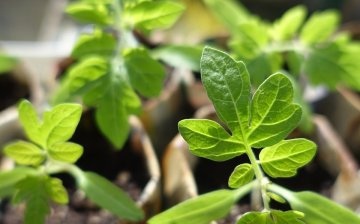

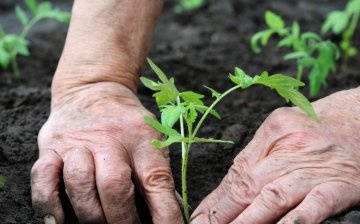
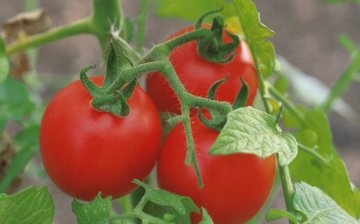






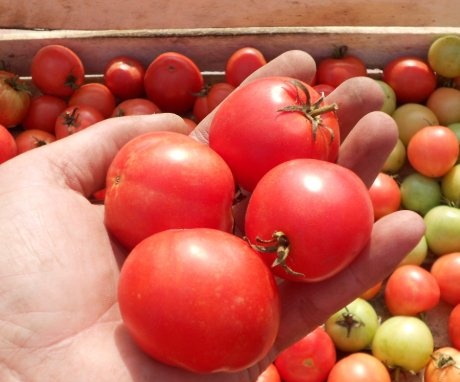

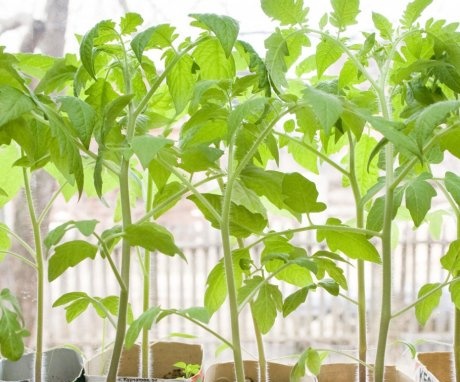
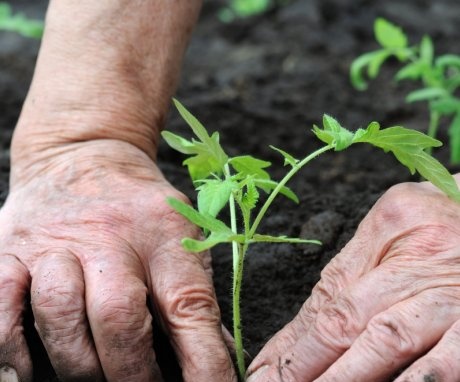
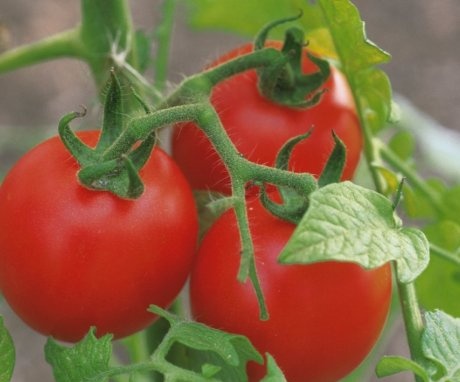
I like this tomato variety for its unpretentiousness and relatively high yield. Planting it with seedlings in early May, in addition to regular watering and treatment against the Colorado potato beetle, the variety does not require any other care.